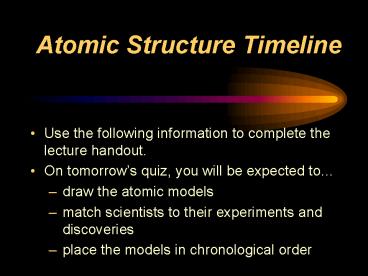Atomic Structure Timeline - PowerPoint PPT Presentation
1 / 15
Title:
Atomic Structure Timeline
Description:
Plum-pudding or Raisin Bun Model. positive sphere (pudding or bun) with. negative electrons (plums or raisins) dispersed throughout. Ernest Rutherford (1911) ... – PowerPoint PPT presentation
Number of Views:128
Avg rating:3.0/5.0
Title: Atomic Structure Timeline
1
Atomic Structure Timeline
- Use the following information to complete the
lecture handout. - On tomorrows quiz, you will be expected to
- draw the atomic models
- match scientists to their experiments and
discoveries - place the models in chronological order
2
Democritus (400 B.C.)
- Proposed that matter was composed of tiny
indivisible particles - Not based on experimental data
- Greek atomos
3
Alchemy (next 2000 years)
- Mixture of science and mysticism.
- Lab procedures were developed, but alchemists did
not perform controlled experiments like true
scientists.
4
John Dalton (1807)
- British Schoolteacher
- based his theory on others experimental data
- Billiard Ball Model
- atom is a uniform, solid sphere
5
John Dalton
Daltons Four Postulates
1. Elements are composed of small indivisible
particles called atoms. 2. Atoms of the same
element are identical. Atoms of different
elements are different. 3. Atoms of different
elements combine together in simple proportions
to create a compound. 4. In a chemical reaction,
atoms are rearranged, but not changed.
6
J. J. Thomson (1903)
- Cathode Ray Tube Experiments
- beam of negative particles
- Discovered Electrons
- negative particles within the atom
- Plum-pudding Model or Raisin Bun Model
7
J. J. Thomson (1903)
- Plum-pudding or Raisin Bun Model
- positive sphere (pudding or bun) with negative
electrons (plums or raisins) dispersed throughout
8
Ernest Rutherford (1911)
- Gold Foil Experiment
- Discovered the nucleus
- dense, positive charge in the center of the atom
- Nuclear Model
9
Ernest Rutherford (1911)
- Nuclear Model
- dense, positive nucleus surrounded by negative
electrons
10
Niels Bohr (1913)
- Bright-Line Spectrum
- tried to explain presence of specific colors in
hydrogens spectrum - Energy Levels
- electrons can only exist in specific energy
states - Planetary Model
11
Niels Bohr (1913)
Bright-line spectrum
- Planetary Model
- electrons move in circular orbits within specific
energy levels
12
Erwin Schrödinger (1926)
- Quantum mechanics
- electrons can only exist in specified energy
states - Electron cloud model
- orbital region around the nucleus where e- are
likely to be found
13
Erwin Schrödinger (1926)
- Electron Cloud Model (orbital)
- dots represent probability of finding an e- not
actual electrons
14
James Chadwick (1932)
- Discovered neutrons
- neutral particles in the nucleus of an atom
- Joliot-Curie Experiments
- based his theory on their experimental evidence
15
James Chadwick (1932)
- Neutron Model
- revision of Rutherfords Nuclear Model































